Winterizing Your Top Bar Hive for the Colder Months
There are important steps to take to help your bees to make it through the winter. Below is a checklist to prepare your beehive for the cold, winter months.
Most of the content in this article is directed toward those who live in cold winter climates. Insulating the beehive, and keeping a full hive of honey is important in areas where you will experience below-freezing temperatures for many days at a time. Obviously, if you live in a very warm climate like Florida it will not be necessary to winterize your hive. Understand that you may need to adjust this information for your specific climate and area.
Leave Honey Stores for the Bees to Overwinter
Because of how the bees use honey over the winter, we find that it is more supportive of the bees to harvest honey in the spring instead of in the fall in colder climates because the bees will need the honey for warmth. Not only do the bees eat the honey over the winter, but they also take advantage of the honeys’ incredible heat storing properties as thermal mass. During the winter days, the honey absorbs warmth from the radiating sun, stores it, and slowly releases that warmth back into the hive throughout the coolness of the evening and night. That being the case, we feel the last honey harvest in the fall should only be to prevent the bees from attaching their comb to the false back. Do not remove more than 1-2 honey combs. Labor Day is a good reference date to keep in mind as around the last time you want to harvest honey. This also leaves enough time in the fall for the bees to re-propolize any broken seals from opening up the hive.
Insulate and Leave Honey for your Bees to Overwinter - Thermal Mass
Insulating hives has two important effects. First, if a hive has marginal honey stores, insulating greatly increases its chances of overwintering. Secondly, because the bees create warmth by eating honey and using this fuel to generate heat by flexing their wing muscles, a hive that is insulated will have many more honey combs to harvest in the spring. The thermal mass of the honeycombs greatly reduces the fluctuation of the nest temperature because the honeycombs act like "thermal batteries" and can store heat during the day and gradually release it at night. The insulation Beehive Cozy Covers substantially add to this effect by buffering both hot and cold outside temperatures
Insulation helps balance out the ever increasing weather anomalies
The most dangerous weather anomaly for the bees is when there are several unusually hot days in the fall and the bees have collected water to cool the hive, only to have the temperature suddenly plummet to freezing in a single day. This situation leaves the bees with moisture in the hive and no way of fanning that moisture out. Our Beehive Cozy Cover will help keep the hive at a more consistent temperature, which is beneficial when the temperatures fluctuate from a temperature like 60 degrees down to 25 degrees in a day.
Checklist to prepare your hive for the winter:
1) Assess Honey Stores - Feel the weight of your hive. Install a feeder cup if your bees don’t have enough honey stored to make it through the winter
2) Move the false back forward
3) Reducing down the entrance of the hive if the bees have not
4) Insulate the hive - the most important step for winterizing
For Winter, Move the False Back Forward

This is a September or October chore.
The false back is included with all of our hives, the Golden Mean, Original BackYardHive and Cathedral Hives. It is a top bar with a thin sheet of wood suspended below it. The false back is kept in the back of the hive in the summer to gain access into the hive easier and is then moved forward up against the last comb for the winter months in order to create a smaller space in the hive that the bees have to keep warm.
Ideally you would want to move the false back before the first snowfall or extended period below 32 degrees Fahrenheit. The false back should be moved forward on a day that is warmer than 50 degrees Fahrenheit so that the hive doesn’t lose too much heat. Also the bees have propolized and sealed up their hive for winter. Normally they start this process in September, so opening the hive to move the falseback will break these seals so it is better to move the falseback forward when the sources of nectar decline in your region. For reference, in Colorado along the front range the end of October would be the absolute latest that one should put the false back in position.

To install the false back, look through the window and determine where the last of the combs have been drawn out. Usually this is near the back of the hive. Remove the top bar at this location and insert the false back snug against the last top bar with comb on it. The next step is to gently loosen all the top bars at the back of the hive from the edge of the hive body. Try to keep them as one unit as you slide them forward against the false back. Keeping the empty top bars together as one unit will ensure that the propolis seal between them is left intact.
If you haven’t already, you may need to move your bees forward in the hive. Moving the bees forward is only necessary if the bees have created their brood combs in the center of the hive and have left empty space in the front of the hive (i.e. no combs drawn on the top bars at the front of the hive). Moving the bees forward decreases the hive volume and is an additional protective measure in cold climates. It is quite important that this is only done during a time that is warm enough to see many bees flying from the entrance. This is an additional step and is more involved, requiring that you are comfortable with your bees and your skill level is developed. In a climate like Colorado, mid-September is the last time that one should move the bees forward in the hive.
To move the bees forward, start by removing the empty top bars at the front of the hive until you get to the first drawn comb. You will begin moving each comb forward, detaching the combs from the sides of the hive as necessary to enable them to be moved.

Prying the top bars apart with the Hive Tool
Continue moving the combs forward one by one, like a filing cabinet, until you have successfully moved all the combs to the front of the hive. When the last comb is repositioned insert the false back behind it. Then take the remaining empty top bars that you removed from the front of the hive and put them behind the false back. “Robbing” may be a problem in the fall, so it is important that all the spaces and gaps are sealed in the top of the hive.
Installing a Feeder Cup if Your Bees Don’t Have Enough Honey Stored
Feeding your bees can be risky, mainly due to potential robbing. Make sure that your bees need to be fed to avoid undue stress to the hive needing to defend off invaders.
The general rule is that if your hive has less than 7 honey combs you may need to offer honey to your bees over the winter.
Lift your hive to know how much honey is stored
Another way to test for the amount of honey in the hive is to lift the back end your hive. If your hive feels fairly heavy, like a 35 pound sack of dog food, there are probably enough honey stores. Get use to the weight in your hive so in the fall and spring you know if your bees are short on honey and need to be fed.
We recommend feeding the bees honey instead of sugar syrup or sugar water, as sugar is not a natural food for the bees. If your hive is in its first year you can use store bought honey, but ideally you would want to use honey you have collected from that hive.
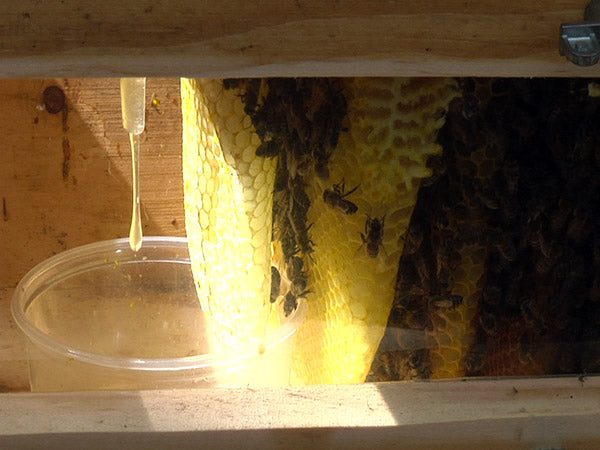
If you have a comb with empty cells you can fill those cells with honey water. Use a 5:1 honey to water mix and fill the cells. A turkey baster works great to squirt the mixture into the empty cells.
Another option is to use a shallow bowl or container - it can be a plastic container reused from a grocery store purchase. It is important that it is shallow enough to slide under a comb or 3, but deep enough so that you will not have to fill it too often (opening the hive in the winter may dangerously cool the bees). Slide your container under 1-3 combs. This is important, because when the bees are cold they cannot move very fast or far, so their food source needs to be close. Place sticks in the container so that when the bees visit the feeder they will not fall in or drown. Besides the combs that the feeder is under, the feeder should stick out 1-2 empty bars or partial combs in the back of the hive.
Place your false back as close to the feeder as you can. Mark on the top of the empty or partially-combed top bar that is above where your feeder is located so that during the cold months of the winter if your bees need more honey you can quickly pull off just that one bar, and pour honey into the hive. Remember, you should install the feeder in the fall on a warm day. If the bees are warm enough to be flying from the hive - about 50 degrees - then it is a good time to do the install. Be sure to move quickly so the hive temperature doesn’t drop too much.
Wait to pour honey in the hive until the end of the day or a few hours before dusk as there will be fewer neighbor bees out and about foraging for robbing opportunities.
Reducing down the entrance of the hive
Bees that know how to close up the hive entrance will have closed up their entrance with propolis, leaving a few small openings. If the bees have the genetic ability or memory they will best know how much they will need to close their entrance. And they will reopen (chew away the propolis) when necessary.
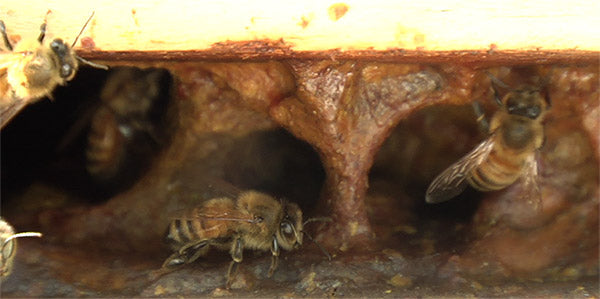
Bees have propolized down the entrance for winter
Reducing down the entrance helps to keep cold winds from entering the hive and it also reduces the amount of robbing your hive may be experiencing. It is best to watch the bees to see if they naturally begin to reduce the entrance on their own with propolis.
If the bees have reduced down their entrance with propolis there is no need
to do anything with the entrance!
If by the end of October you have not observed the bees closing up the hive, you will need to help them by putting some small twigs, straw, or grass over part (about half) of the entrance. With materials like these, the bees can push out the twigs or straw on their own when they need to. Learn more about Entrance Reducing your hive
Why is there fighting going on at the front of the hive?
Toward the end of the gathering season, weakened hives may experience a problem with “robbing”. Robbing is when bees from another hive charge through the entrance, pass the guards, and begin to steal honey. Having an open container of honey in a weakened hive may attract this behavior. You can determine robbing behavior by looking in the window. Robbing bees will be seen scurrying along the sides of the glass, moving quickly to the honey stores. There is usually fighting or bees hanging on the legs of intruder bees to remove them. So to prevent this we suggest that you do two things. First, wait to pour honey in the hive until the day before a cold snap since robbing behavior usually stops after the first frost. Secondly, place some twigs or sticks over part of the entrance to reduce the area the bees will have to defend.
But be careful, the temperature warms up too much, the bees will have a hard time ventilating the hive so you may need to remove some of the twigs or sticks. If this happens, your hive may acquire too much moisture, which can stress the hive as the temperature drops below freezing. For winter feeding, pour a tiny bit of hot water into the honey to make it less viscous so it pours well. To get the honey into the hive, we suggest using a turkey baster.
We no longer send entrance reducers with the hives. With weather anomalies and drastically fluctuating temperatures, putting in an entrance reducer can over heat the hive. When the temperatures rise to 70 degrees in November or December, and the bees need to cool the hive they can not push out this entrance reducer, resulting in over heating the hive and this over heating may kill the colony.
Insulate Your Hive with our Beehive Cozy Cover
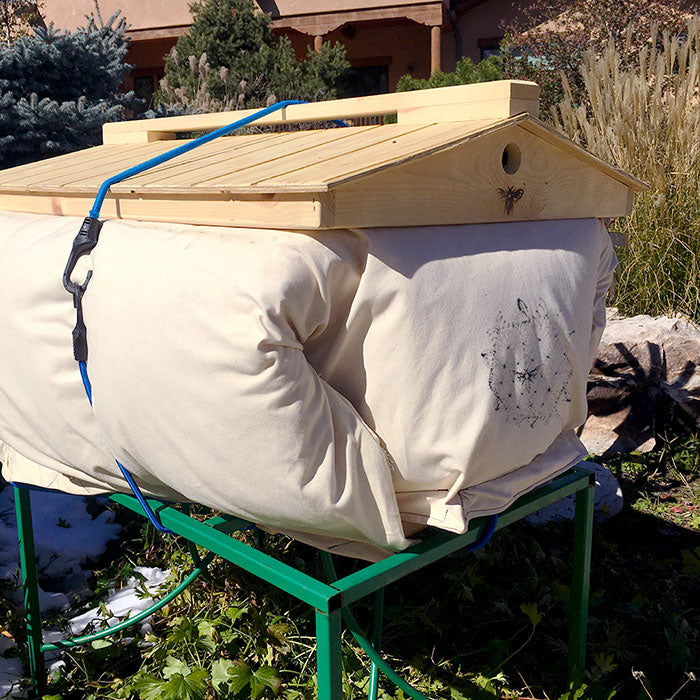
The new Beehive Cozy Cover
There are actually many different materials you can use to winterize your hive. You can be pretty creative with this process and find the perfect solution for your climate and situation. However, here at BackYardHive we typically use our new Beehive Cozy Cover. The Cozy fits the Golden Mean Hive, the Original BackYardHive, the Cathedral Hive and most popular top bars hives our there. We like to give the bees the best insulation protection we can; we find that it gives them a real boost when spring comes.
For climates similar to Colorado, you will want to have the Beehive Cozy Cover other in place by the end of October.
Insulating the hive can add to your spring harvest because the bees will not need as much of their honey for fuel or warmth to get them through the winter. Another advantage to insulating the hive is that the bees will be able to start their brood earlier in the spring, so there will be larger numbers of bees ready to head out for the spring nectar flows.
You may wonder why we need to insulate our hive when in nature they do not need insulation. Well, actually they do. Wild bees that survive in a harsh winter climate tend to live inside hollow tress with thick walls (insulation) protecting the bees from the harsh winter elements.
Make sure that the entrance to the hive is opened all winter to allow the bees to come and go. During the winter the bees may need to leave the hive on warmer days to gather water, or to go on a cleansing flight. So after heavy snowfalls, check your hive entrance to make sure it is open for the bees.
We consider winterizing the hive a crucial part of the bee guardian method. This simple and fun maneuver insures that our partnership and exchange with the bees continues into the next year. In the spring you may congratulate yourself for assisting the bees as you once again witness your environment come alive with the delightful hum of the honey bee.
Does using insulation heat up my hive?
Insulation does not heat up the hive, it insulates inside temperatures from outside temperatures.
Because the bees generate heat by flexing their wing muscles, they are the heater. If we were in a tent that had no insulation a heater would be pretty useless in sub-zero or cold temperatures. Say we put the same heater in a cabin with great insulation, we would probably have to turn off the heater shortly because we would "capture" the heat within the dwelling due to the insulation keeping the “heat” or warmth inside the cabin.
Same with cooling, the bees are cooling their hive with water vapor and fanning their wings, i.e. creating "air conditioning". This is the same principle as air conditioning in our modern homes that are insulated. If we put an air conditioner in a tent with no insulation on a hot day we would have to run the air conditioner on high all day to keep the temperature comfortable. If we put big panels of insulation around the tent, now we have insulated the inside cool air from the outside hot air, so the less we have to run the air conditioner.
Warm winter days will not overheat the hive. If it is cold out, it will get colder in the hive and the bees will warm the hive. The insulation helps keep in this warmth. If it is cold weather for several days or weeks and then the temperatures suddenly warm up and the sun is out beating down on the hive, the insulation will keep the hive from getting too warm. And in the winter when the days are shorter by the time it warms up a bit it is already starting to cool down.
In cold climates you can keep the Cozy Cover on from October through March, as we sometimes still get temperature drops and snow in March (sometimes into April).
How about using straw bales set around the hive in the winter?
Well, kind of a good idea, but there are some big issues. The biggest problem with straw bales is keeping them dry. As soon as the straw gets wet, there are mold issues and a hive surrounded by moldy straw bales is not a good idea. The second problem is that the bales attract mice and by the time spring rolls around the bales are usually full of mice. So one better have a mouse guard on their hive for the winter.
 Straw Bales - not such a good idea, the bales mold and attract mice
Straw Bales - not such a good idea, the bales mold and attract mice
Speaking of mice, in the winter months you can place a mouse guard on the front of your hive using 1/4" metal hardware cloth staples on the front.
 Mouse Guard on Bee Hive - 1/4" hardware cloth over the entrance so bees can get in and out but mice can not.
Mouse Guard on Bee Hive - 1/4" hardware cloth over the entrance so bees can get in and out but mice can not.
What if I have the Insulation Panels?
We no longer use the Insulation Panels or any blue or pink foam board insulation. The winter studies at Cornell University and several apiaries with our Cozy Cover we find the breathability of the wool and canvas make it ideal. The foam can be detrimental in some climates and is not breathable
Related Articles
Bees Robbing a HiveWinter Feeding in a Top Bar Hive


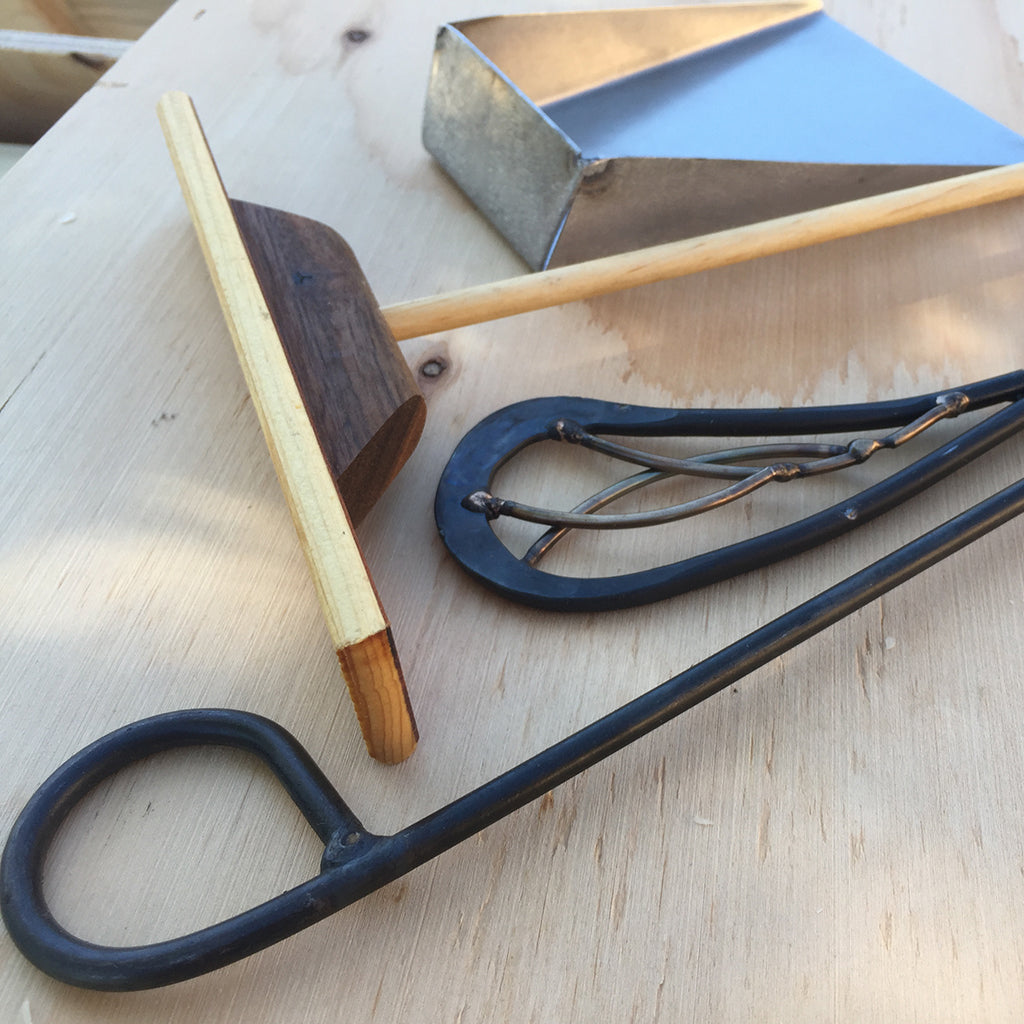
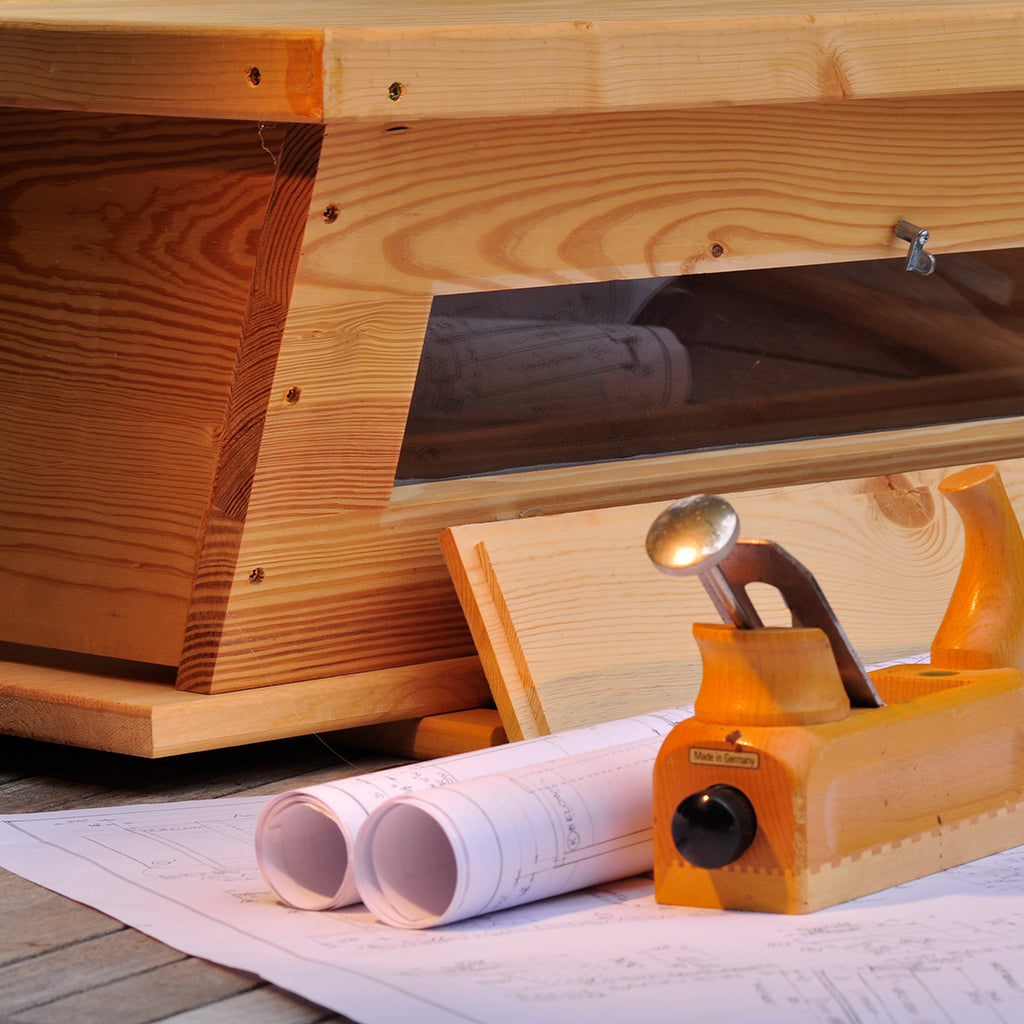
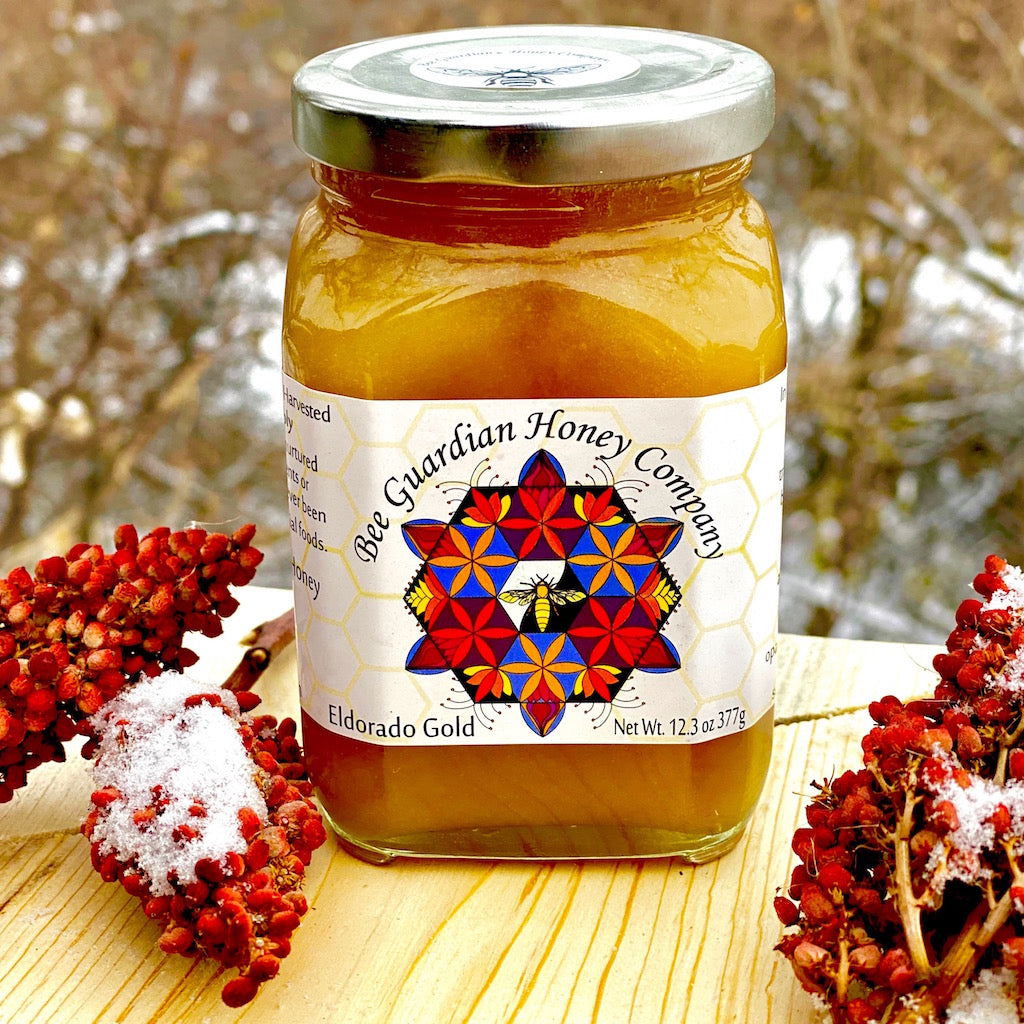
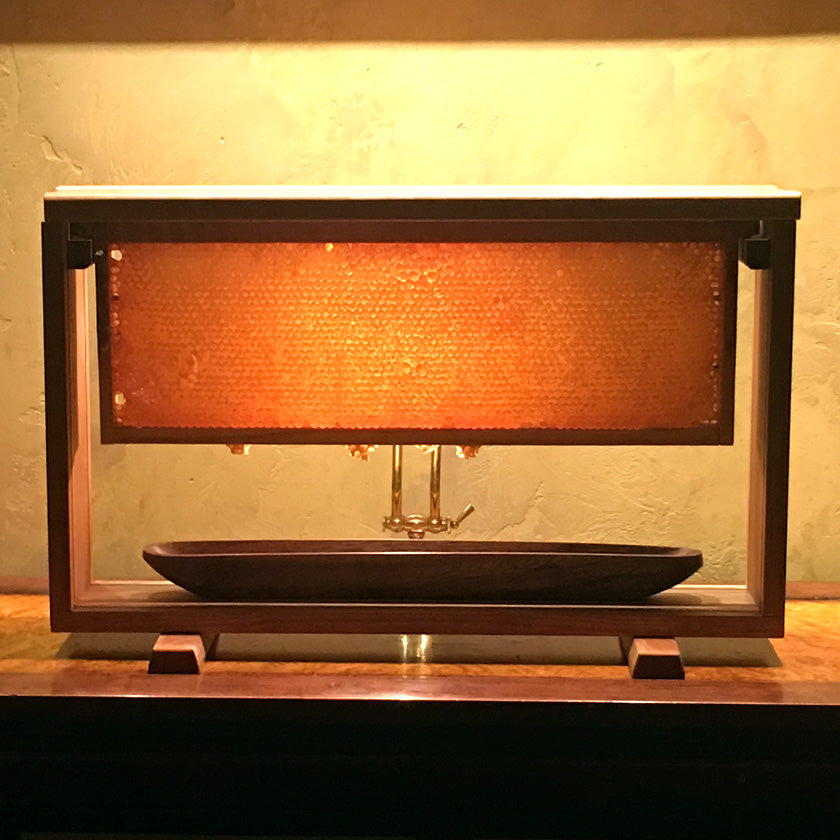
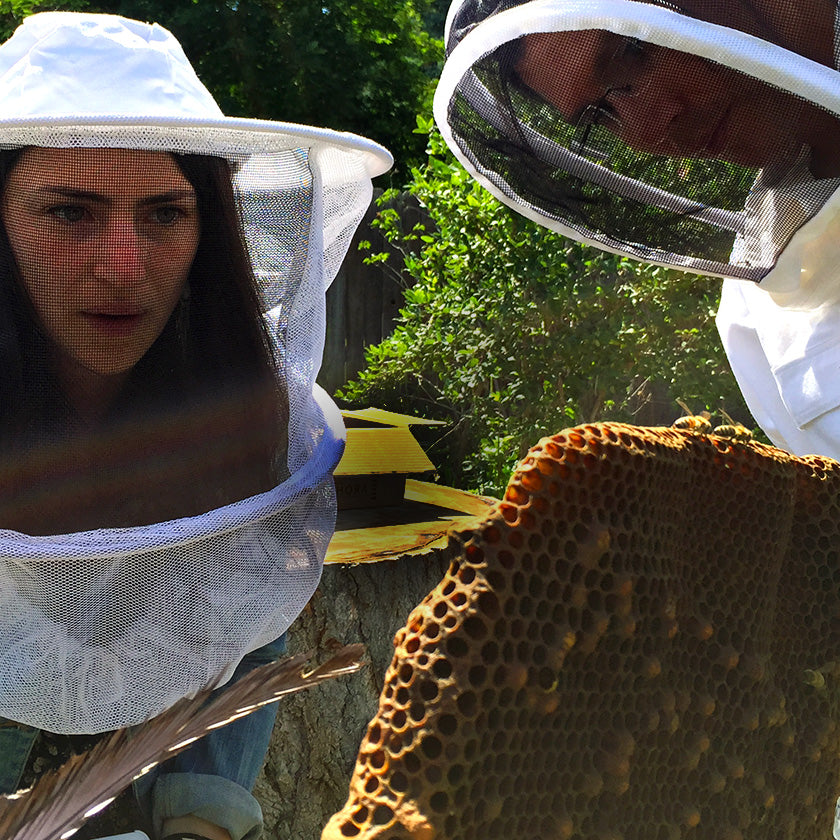
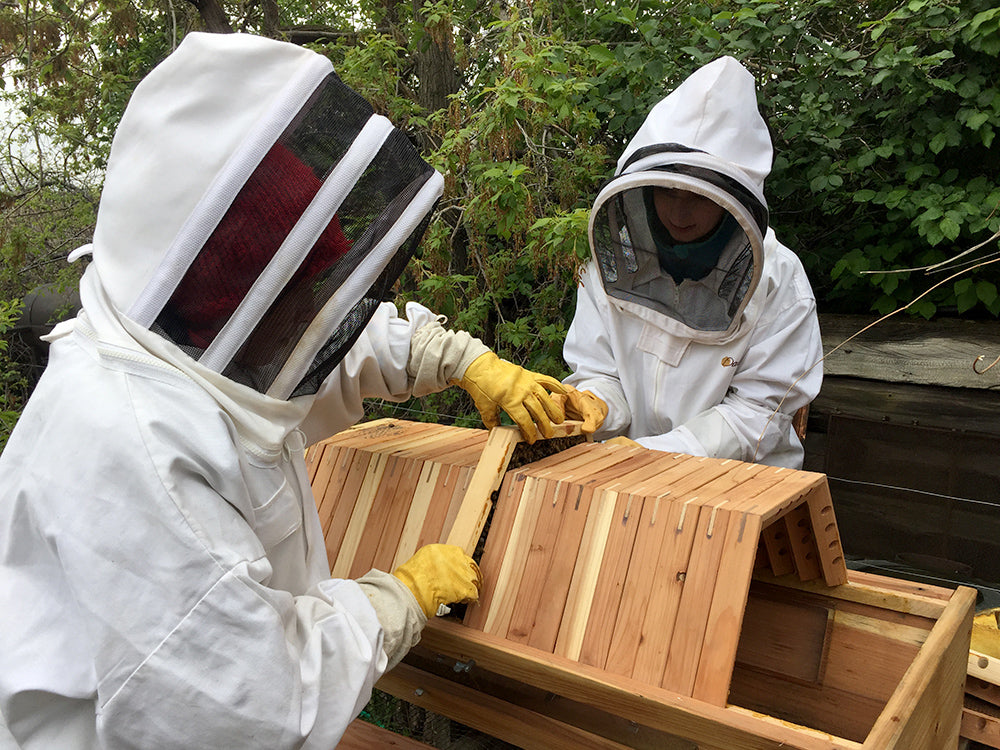
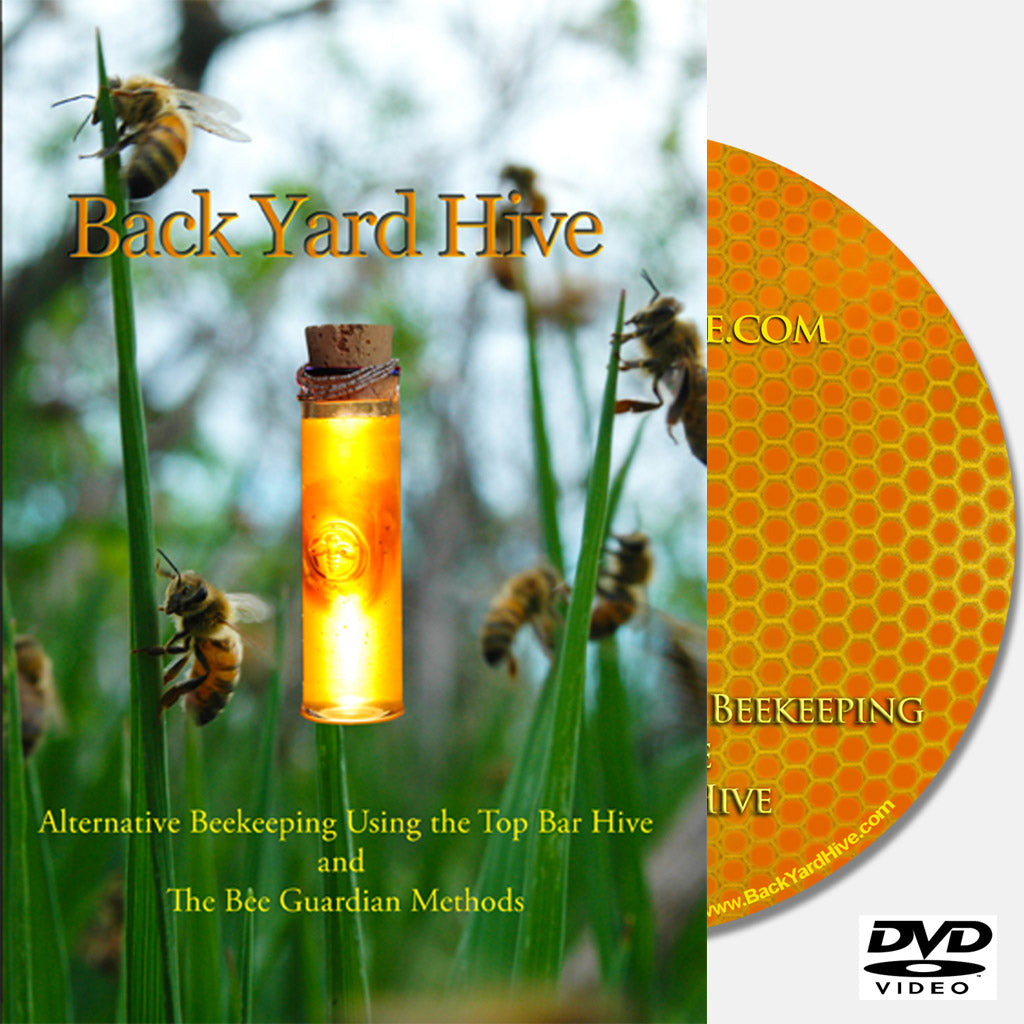


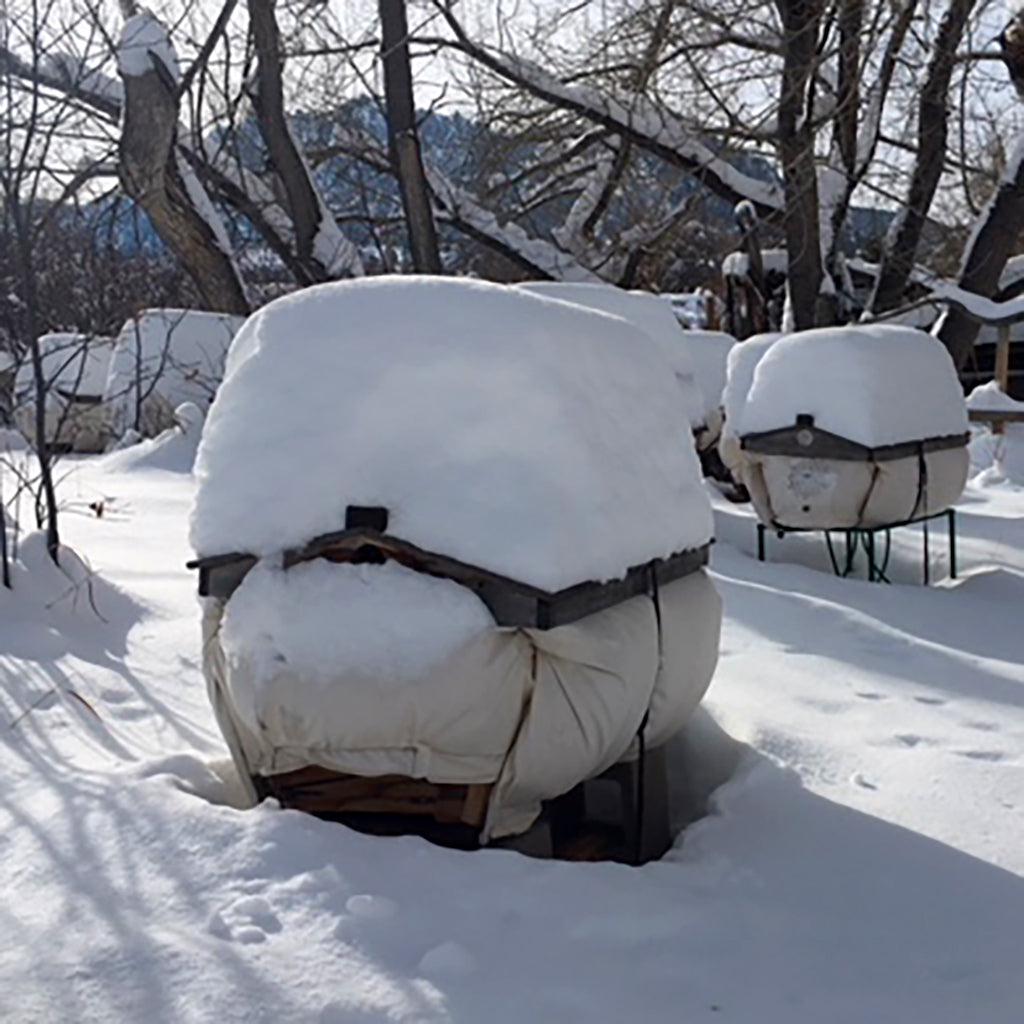
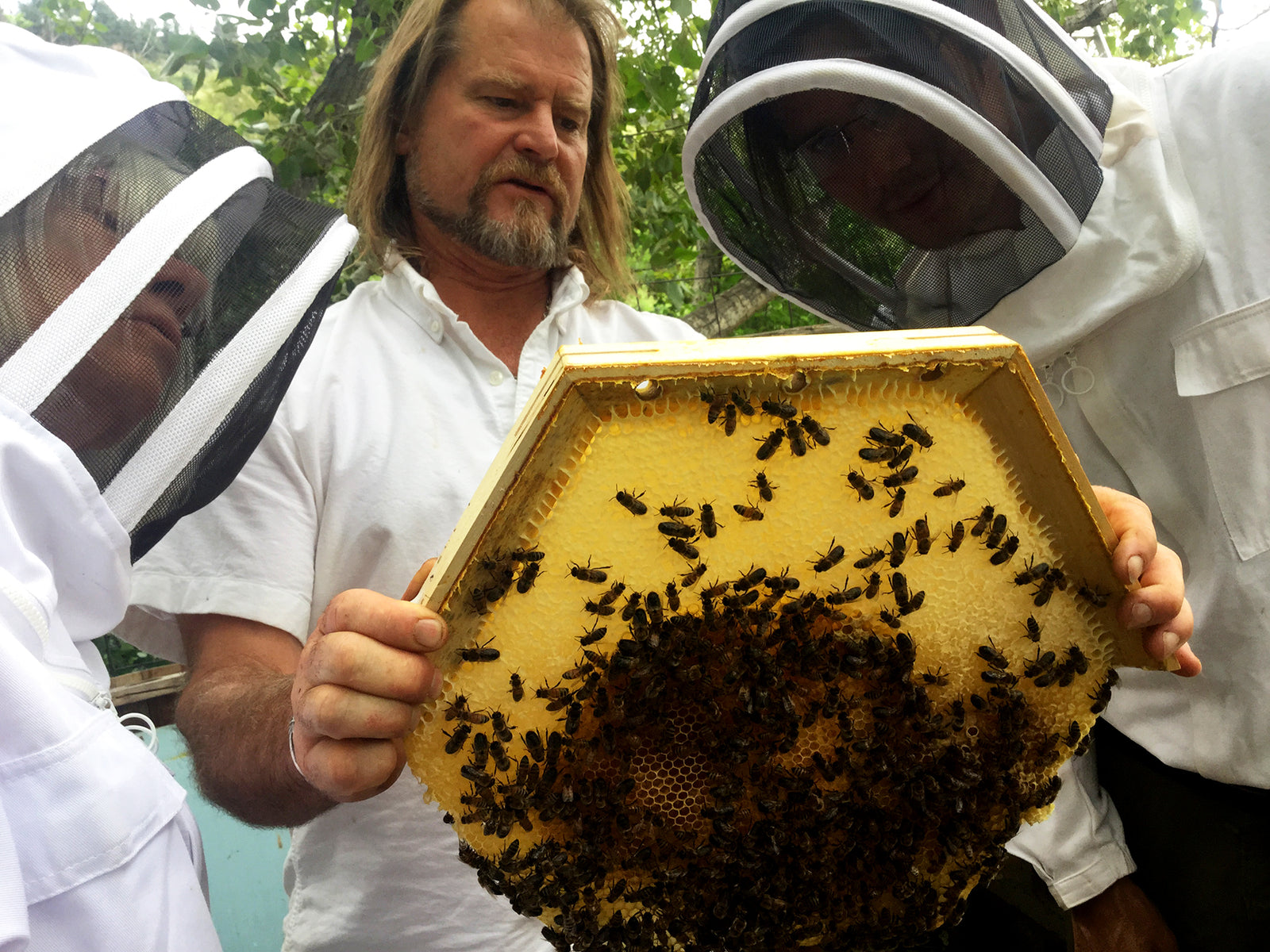


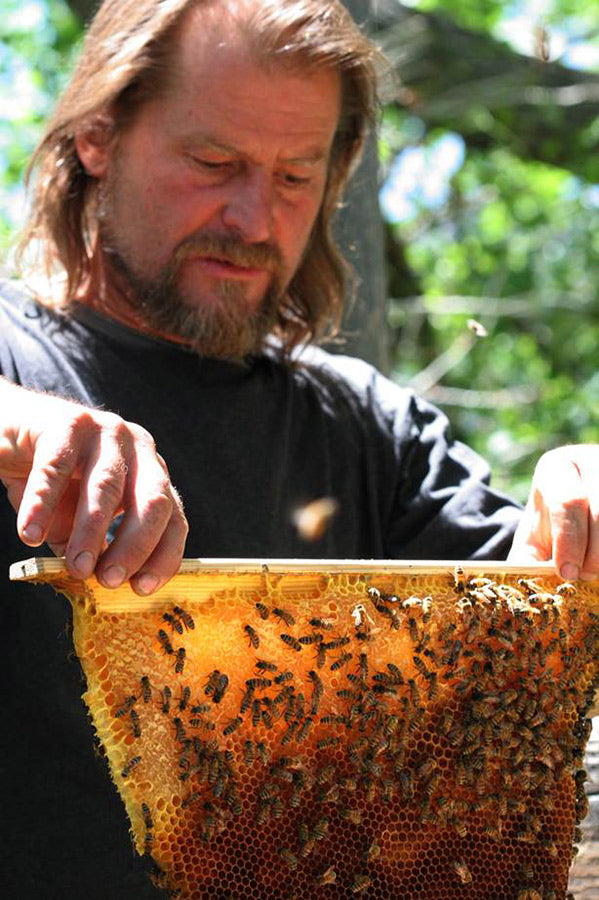







 Straw Bales - not such a good idea, the bales mold and attract mice
Straw Bales - not such a good idea, the bales mold and attract mice Mouse Guard on Bee Hive - 1/4" hardware cloth over the entrance so bees can get in and out but mice can not.
Mouse Guard on Bee Hive - 1/4" hardware cloth over the entrance so bees can get in and out but mice can not.